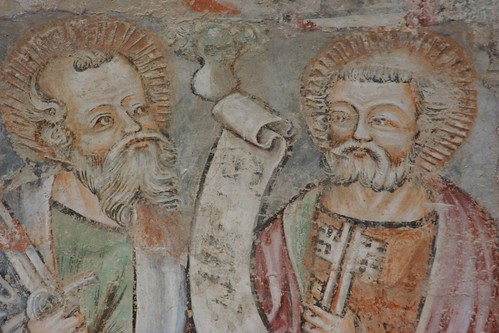 |
88 year of Erwin looking at the destruction at the church of Rotbach/Rotbav
Photo: Inquam Photos / Attila Szabó / Facebook
|
Most of the churches are now not in use. Their treasures have been transported to the bigger churches of the region, and their maintenance is not duly carried out. Many stories are known of valuable furnishing stolen from the churches, or damaged. In fact, several of the buildings themselves are in danger of collapsing. Here are two recent examples:
 |
| Radeln/Roadeș/Rádos, tower |
1. On February 14th, 2016, the late medieval tower of the fortified church of Radeln/Roadeș/Rádos partially collapsed. There is an imminent danger that the tower may collapse entirely, likely damaging the church itself. The church had most recently been in the news in 1998, when panels of its late Gothic altarpiece were stolen. Luckily, the damaged panels were recovered a few years later, and the altarpiece now stands in one of the churches of Hermannstadt/Sibiu. Most recently, it was reported that medieval frescoes - most likely painted by the workshop of the Székelyderzs/Dirjiu master, and thus dating from around 1420 - were found under the plaster on the walls (see on the right). No doubt, the church still holds many treasures and has to be saved.
Several foundations took up the task of preserving the church - Wikipedia reports on the Peter Maffay Stiftung, among others - but apparently not much has been done to actually structurally protect the building.
2. On February 19th, 2016, one of the most monumental church towers in southern Transylvania, the tower of Rotbach/Rotbav/Szászveresmart collapsed entirely. The tower had been an important sight on the road towards Kronstadt/Brasov/Brassó. It dates from the Middle Ages, although it had been enlarged and rebuilt in later centuries. It was reported that at 9 PM, the bell was only struck twice, and then the entire tower collapsed, burying part of the nave under the rubble. I am not aware of any reports about the state of the tower prior to the collapse - it is not clear when the building was last surveyed. But in any case, a significant landmark was lost forever, an the fate of the remaining church building is uncertain at best.
 |
| Rotbach/Rotbav/Szászveresmart - Before and after |
 |
| Rotbach/Rotbav/Szászveresmart - Bell under the rubble |
Ministerul Culturii propune constituirea „Fondului de urgență pentru patrimoniu”Reprezentanți ai Ministerul Culturii...
Posted by Vlad Alexandrescu on Sunday, February 21, 2016















